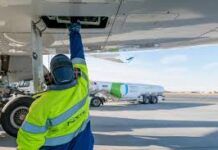
AVweb’s General Aviation Accident Bulletin is taken from the pages of our sister publication, Aviation Safety magazine and is published twice a month. All the reports listed here are preliminary and include only initial factual findings about crashes. You can learn more about the final probable cause in the NTSB’s web site at www.ntsb.gov. Final reports appear about a year after the accident, although some take longer. Find out more about Aviation Safety at www.aviationsafetymagazine.com.
Aviat Aircraft A-1B Husky
November 2, 2016, Geneva, Florida
The airplane was substantially damaged at about 1100 Eastern time when it impacted a fence during a precautionary landing. The solo commercial pilot was not injured. Visual conditions prevailed.
According to the pilot, about 10 minutes into an otherwise-normal the flight, the engine began to “run rough.” The pilot adjusted the power controls, but the engine started to backfire and continued to lose power. He made a spiraling descent from about 1000 feet agl and maneuvered the airplane to land on a paved area of a driving track. During the landing roll, the airplane struck a fence. The pilot stated the engine continued to operate throughout the landing and landing roll until the airplane struck the fence.
Van’s RV-10 Experimental
November 5, 2016, Dubois, Wyoming
At about 0756 Mountain time, the airplane was destroyed during a post-impact fire following a loss of control shortly after takeoff. The solo private pilot was fatally injured. Visual conditions prevailed.
A pilot-witness reported seeing the accident airplane’s right-side gull-wing door open immediately after liftoff. After the door opened, he saw the pilot reach for the fully open door with his right hand and heard a momentary reduction of engine power. The airplane descended momentarily before increasing in engine power and leveling off over the runway, with the pilot continuing to reach for the open cabin door at about 35 feet agl. The airplane’s left wing and nose dropped suddenly and it descended below his line of sight before he observed a large explosion.
Beech Model 76 Duchess
November 5, 2016, Davis, California
During the takeoff roll for a flight review, the instructor pulled the left engine mixture control to simulate an engine failure, but the pilot “froze” at the controls and the airplane veered left. The flight instructor attempted to fail the right engine via the right mixture control in order to regain directional control, but his hand came off the mixture control and the airplane exited the runway. During the runway excursion, the flight instructor “finally got [his] hand back on the right mixture and pulled it to idle cut-off.” Subsequently, the nose landing gear collapsed.
Stinson L-5 Sentinel
November 6, 2016, San Marcos, Texas

At about 1222 Central time, the airplane nosed over during a forced landing. The private pilot and passenger received minor injuries; the airplane was substantially damaged. Visual conditions prevailed.
The pilot performed a go-around while attempting to landing, and the engine lost power during the initial climb. The pilot attempted to land on another runway, but the airplane rolled onto soft terrain between the runways. The left main gear collapsed and the airplane nosed over.
Cessna 172 Skyhawk
November 6, 2016, Englewood, Colorado
While en route at about 2500 feet agl in dark night visual conditions, multiple birds struck both wings and the cowling. The airplane had a “harsh rolling tendency to the right and reduced engine power.” The pilot declared an emergency with ATC and landed without further incident at an airport about three nautical miles away. The right wing sustained substantial damage.
Cessna T210 Turbo Centurion
November 06, 2016, Twentynine Palms, California
At about 0900 Pacific time, the airplane departed the runway after its right main landing gear collapsed during a precautionary landing. The solo private pilot was not injured but the airplane sustained substantial damage to its right wing and firewall. Visual conditions prevailed.
After takeoff, the pilot retracted the landing gear, but indicators failed to show the gear being stowed and the landing gear doors remained open. He extended the gear and operated the emergency gear extension handle, but did not receive an indication the gear was down and locked. During the landing roll, the right main landing gear collapsed. The airplane departed the runway and struck a ditch, collapsing the nose landing gear and damaging the right wing.
Cessna 177B Cardinal
November 8, 2016, Hopkinton, Rhode Island
The airplane was substantially damaged during a forced landing at about 1415 Eastern time. The solo private pilot was not injured. Visual conditions prevailed.
During cruise flight at about 1800 feet msl, the engine suddenly lost all power. The pilot attempted to restart the engine but was unsuccessful and executed a forced landing. During the landing roll, the airplane impacted two small trees before coming to rest, resulting in substantial damage. The pilot stated the purpose of the flight was to get fuel. Examination did not reveal any fuel in the compromised fuel tanks, nor was there any blighting of the grass or any other evidence of a fuel spill.
Beech Model 36 Bonanza
November 9, 2016, Ormond Beach, Florida
At about 1330 Eastern time, the airplane was substantially damaged shortly after takeoff. The private pilot and the pilot-rated passenger were seriously injured. Visual conditions existed at the time of the accident.
According to law enforcement personnel, the pilot “thought a flight control cable had failed, which resulted in an uncontrolled descent into wooded terrain.” Weather about five miles southeast of the accident site included wind from 030 degrees at five knots, visibility 10 miles, scattered clouds at 3200 feet and an overcast at 7000 feet.
North American Navion
November 10, 2016, Blairstown, New Jersey
The airplane was substantially damaged at about 0915 Eastern time following a loss of control during engine startup. The private pilot was fatally injured. Visual conditions prevailed.
According to a mechanic who witnessed the accident, the airplane was supposed to be ferried for an annual inspection after major repairs. The ferry pilot was not available, however, and the owner/pilot elected to fly the airplane himself. After fueling the airplane and completing a preflight inspection, the pilot/owner started the engine, which immediately went to full power. The engine remained at full power and the airplane taxied at high speed into a tree. Examination revealed the throttle, propeller and mixture controls were all in the full-forward position.
Piper PA-32R-301 Saratoga SP
November 11, 2016, Bethel, Alaska
At about 1650 Alaska time, the airplane sustained substantial damage during a forced landing following a loss of engine power. The solo commercial pilot sustained minor injuries. Visual conditions prevailed for the public aircraft operation.
The pilot later reported he was climbing out through about 800 feet agl when he heard and felt a momentary vibration and noted engine oil pressure read at zero psi. He made an immediate left turn back to the airport and declared an emergency with ATC. Shortly thereafter, the engine seized and the propeller stopped rotating. The pilot maneuvered to land in the tundra-covered terrain southwest of the airport. During the rollout, he felt multiple impacts, followed by the airplane skidding to the left. The nose and left main landing gear collapsed during the skid.
This article originally appeared in the February 2017 issue of Aviation Safety magazine.
For more great content like this, subscribe to Aviation Safety!
































